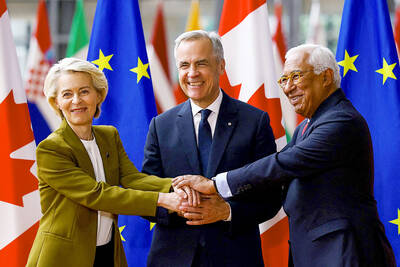One day, when nature calls, your urine could be put to better use than being flushed down the toilet.
Instead it could be a key ingredient in the construction of a greener office or new home.
In one of the latest innovations in the search for eco-friendly building materials, South African university researchers have created bricks using human urine.
The first of their kind in the world, the bio-bricks hold out the prospect of a sustainable alternative to standard clay and concrete bricks, they hope.
The prototypes have been “grown” from urine using a technique somewhat similar to the natural formation of seashells, taking six to eight days to form.
The groundbreaking invention is the brainchild of two University of Cape Town students and a lecturer.
With a grant from a government-run Water Research Council, the feasibility study was launched last year using synthetic urea and then the study escalated to using human urine.
“I was always curious to know why don’t we use urine to do the same thing,” said Dyllon Randall, the lecturer who supervised one of the two students. “The simple answer is: ‘Yes, we can.’”
A year later they successfully produced their first bio-brick in a laboratory.
Using a natural process known as microbial carbonate precipitation, they mix urine, sand and bacteria to make the brick.
The research is still in its early days. So far, it requires up to 30 liters of urine to make just one brick — with the urine provided by male students at the university via a special urinal.
“We basically made the first bio-brick from real urine,” Randall said. “This process is amazing because essentially what we’ve done is we grew bricks at room temperature.”
The first three bricks are on display. They are gray weighty blocks and indistinguishable from any standard limestone.
Suzanne Lambert, a civil engineering master’s student, marvels at how the team copied “nature’s natural processes” to create a sustainable way of building.
“This process mimics the way coral is formed and the natural processes produce a cement,” she said.
Conventional bricks or clay-fired bricks are manufactured in kilns, where they are dried at 1,400°C, a process that causes large emissions of carbon dioxide.
In contrast, the bio-brick is “grown” through loose sand seeded with bacteria that produce an enzyme called urease.
The urease reacts with the urea in urine to produce a cement-like compound that bonds with the sand.
The product can be molded into any shape and dries at ambient temperatures — no ovens, no greenhouse-gas emissions.
“We take something that is considered a waste stream such as urine and use it in a completely sustainable process,” Randall said.
For those concerned about the odor of urine permeating from the walls, the good news is that the brick does not smell.
Fellow researcher Vukheta Mukhari said the strength of the brick can be tailored to specific building requirements, but the ones they have produced so far are “as strong as common bricks you find on the market.”
Will the bio-brick one day supplant standard clay or concrete counterparts?
The key factor is price.
“We are still far from actually commercializing this as a full-scale system,” Randall said, but added there was plenty of scope for gains in efficiency. “At the moment we need between 20 to 30 liters to make one standard brick... We are looking at reducing the amount of urine we are requiring to make one brick and I’m sure within the next few years will have much better results.”

The team behind the long-awaited Vera Rubin Observatory in Chile yesterday published their first images, revealing breathtaking views of star-forming regions as well as distant galaxies. More than two decades in the making, the giant US-funded telescope sits perched at the summit of Cerro Pachon in central Chile, where dark skies and dry air provide ideal conditions for observing the cosmos. One of the debut images is a composite of 678 exposures taken over just seven hours, capturing the Trifid Nebula and the Lagoon Nebula — both several thousand light-years from Earth — glowing in vivid pinks against orange-red backdrops. The new image

Canada and the EU on Monday signed a defense and security pact as the transatlantic partners seek to better confront Russia, with worries over Washington’s reliability under US President Donald Trump. The deal was announced after a summit in Brussels between Canadian Prime Minister Mark Carney and European Commission President Ursula von der Leyen and European Council President Antonio Costa. “While NATO remains the cornerstone of our collective defense, this partnership will allow us to strengthen our preparedness ... to invest more and to invest smarter,” Costa told a news conference. “It opens new opportunities for companies on both sides of the

ESPIONAGE: The British government’s decision on the proposed embassy hinges on the security of underground data cables, a former diplomat has said A US intervention over China’s proposed new embassy in London has thrown a potential resolution “up in the air,” campaigners have said, amid concerns over the site’s proximity to a sensitive hub of critical communication cables. The furor over a new “super-embassy” on the edge of London’s financial district was reignited last week when the White House said it was “deeply concerned” over potential Chinese access to “the sensitive communications of one of our closest allies.” The Dutch parliament has also raised concerns about Beijing’s ideal location of Royal Mint Court, on the edge of the City of London, which has so

OVERHAUL: The move would likely mark the end to Voice of America, which was founded in 1942 to counter Nazi propaganda and operated in nearly 50 languages The parent agency of Voice of America (VOA) on Friday said it had issued termination notices to more than 639 more staff, completing an 85 percent decrease in personnel since March and effectively spelling the end of a broadcasting network founded to counter Nazi propaganda. US Agency for Global Media (USAGM) senior advisor Kari Lake said the staff reduction meant 1,400 positions had been eliminated as part of US President Donald Trump’s agenda to cut staffing at the agency to a statutory minimum. “Reduction in Force Termination Notices were sent to 639 employees at USAGM and Voice of America, part of a